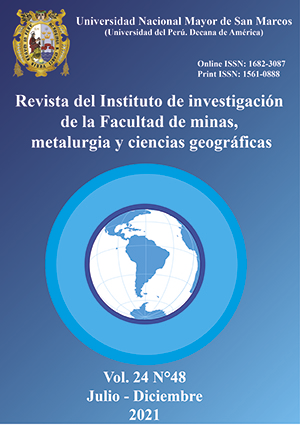Application of electrocoagulation in the removal of heavy metals in galvanic effluents
DOI:
https://doi.org/10.15381/iigeo.v24i48.19828Keywords:
Galvanic effluents, electrocoagulation, heavy metal removal, wastewaterAbstract
The search for new technologies aimed at treating industrial effluents has made electrocoagulation the most widely accepted emerging technology for treating galvanic effluents, which by their very nature contain high concentrations of heavy metals. The objective of this research is the effective elimination of the final heavy metal load through electrocoagulation in wastewater of galvanic origin, using aluminum (anode) and iron (cathode) electrodes, in a continuous reactor. The effects of parameters such as pH, current density and voltage, on the removal efficiencies of heavy metals were studied. The experimental results showed that the optimum pH where the highest removal percentages were reached was 6 (Chrome 96.8%, copper 98.1%, nickel 96.6% and zinc 98.1%). Removal efficiency was found to increase with an increase in voltage and current density, reaching 7.5 volts and 19 A / m2 the highest removal values respectively. It can be concluded, with the experimental results obtained, that electrocoagulation is very effective in removing heavy metals from galvanic effluents.
Downloads
Published
Issue
Section
License
Copyright (c) 2021 Ernesto León Vilela, Vidal Aramburú Rojas

This work is licensed under a Creative Commons Attribution 4.0 International License.
AUTHORS RETAIN THEIR RIGHTS:
a. Authors retain their trade mark rights and patent, and also on any process or procedure described in the article.
b. Authors retain their right to share, copy, distribute, perform and publicly communicate their article (eg, to place their article in an institutional repository or publish it in a book), with an acknowledgment of its initial publication in the Rev. Inst. investig. Fac. minas metal cienc. geogr.
c. Authors retain theirs right to make a subsequent publication of their work, to use the article or any part thereof (eg a compilation of his papers, lecture notes, thesis, or a book), always indicating the source of publication (the originator of the work, journal, volume, number and date).























